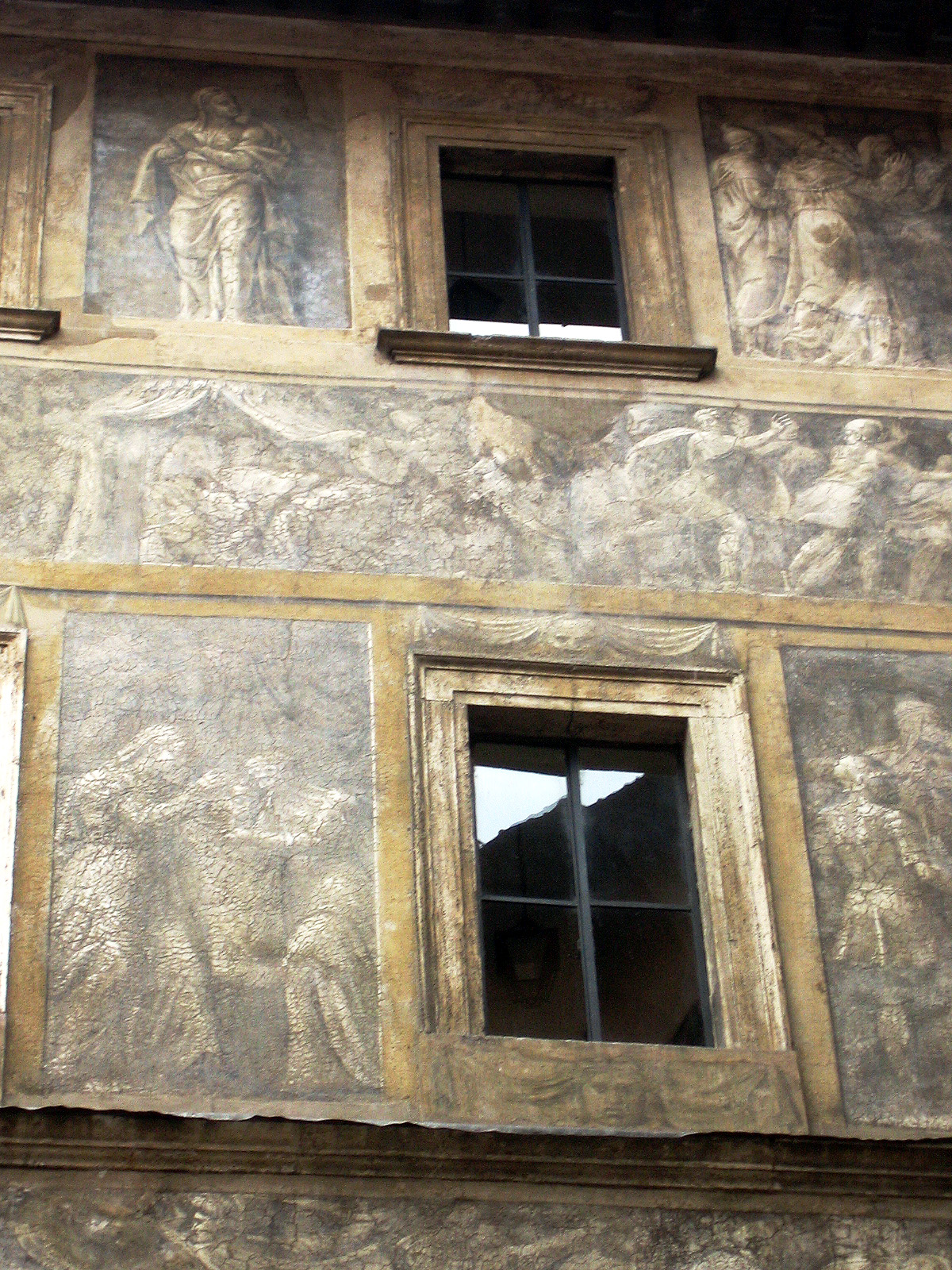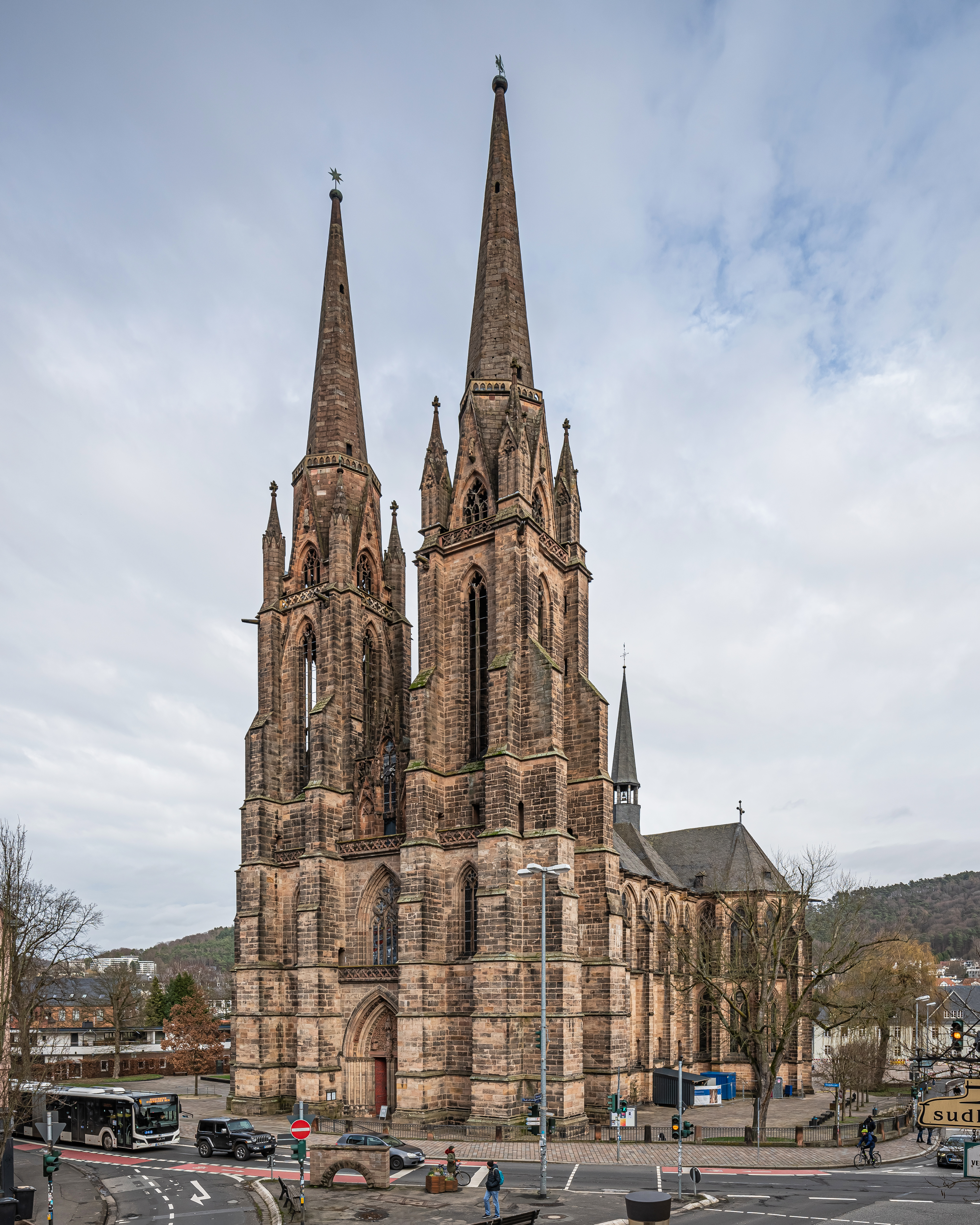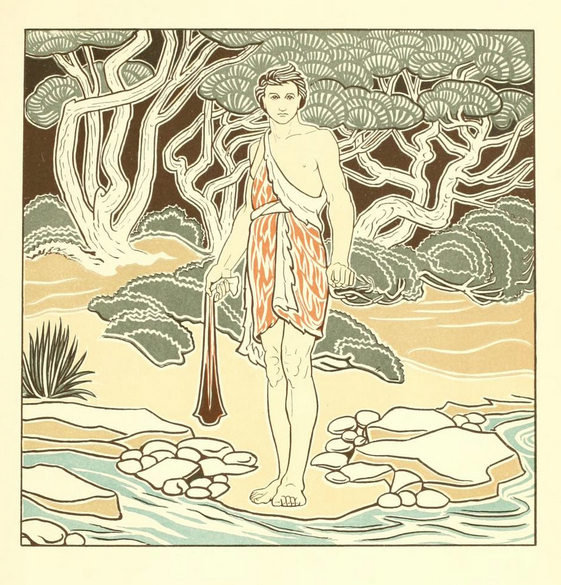|
Sgraffiti
''Sgraffito'' (; plural: ''sgraffiti'') is a technique either of wall decor, produced by applying layers of plaster tinted in contrasting colours to a moistened surface, or in pottery, by applying to an unfired ceramic body two successive layers of contrasting slip or glaze, and then in either case scratching so as to reveal parts of the underlying layer. The Italian past participle ''sgraffiato'' is also used, especially of pottery. Etymology The word ''sgraffito'' comes from the Italian language and is derived from ''graffiare'' ("to scratch"), ultimately from the Greek (''gráphein'', "to write"). Related terms include '' graffito'' and ''graffiti''. History Sgraffito on walls has been used in Europe since classical times. It was popularized in Italy in the 15th and 16th centuries and can be found in African art. In combination with ornamental decoration these techniques formed an alternative to the prevailing painting of walls. The technical procedure is relatively simpl ... [...More Info...] [...Related Items...] OR: [Wikipedia] [Google] [Baidu] |
Art Nouveau
Art Nouveau (; ) is an international style of art, architecture, and applied art, especially the decorative arts. The style is known by different names in different languages: in German, in Italian, in Catalan, and also known as the Modern Style (British Art Nouveau style), Modern Style in English. It was popular between 1890 and 1910 during the Belle Époque period, and was a reaction against the academic art, eclecticism and historicism of 19th century architecture and decoration. It was often inspired by natural forms such as the sinuous curves of plants and flowers. Other characteristics of Art Nouveau were a sense of dynamism and movement, often given by asymmetry or whiplash lines, and the use of modern materials, particularly iron, glass, ceramics and later concrete, to create unusual forms and larger open spaces.Sembach, Klaus-Jürgen, ''L'Art Nouveau'' (2013), pp. 8–30 One major objective of Art Nouveau was to break down the traditional distinction between fine ... [...More Info...] [...Related Items...] OR: [Wikipedia] [Google] [Baidu] |
Marburg
Marburg ( or ) is a university town in the German federal state (''Bundesland'') of Hesse, capital of the Marburg-Biedenkopf district (''Landkreis''). The town area spreads along the valley of the river Lahn and has a population of approximately 76,000. Having been awarded town privileges in 1222, Marburg served as capital of the landgraviate of Hessen-Marburg during periods of the fifteenth to seventeenth centuries. The University of Marburg was founded in 1527 and dominates the public life in the town to this day. Marburg is a historic centre of the pharmaceutical industry in Germany, and there is a plant in the town (by BioNTech) to produce vaccines to tackle Covid-19. History Founding and early history Like many settlements, Marburg developed at the crossroads of two important early medieval highways: the trade route linking Cologne and Prague and the trade route from the North Sea to the Alps and on to Italy, the former crossing the river Lahn here. A first mention o ... [...More Info...] [...Related Items...] OR: [Wikipedia] [Google] [Baidu] |
Alfred Lys Baldry
Alfred Lys Baldry (1858 – 18 May 1939) was an English art critic and painter. He was born in Torquay, Devon, the son of Alfred Baldry and Charlotte Whitehead. Baldry studied at the University of Oxford and the Royal College of Art, and as a pupil of Albert Joseph Moore. He exhibited works during the 1880s. Later he was Moore's biographer, this being an 1892 commission from Montague Marks, editor of ''Art Amateur''. After Moore's death in 1893 he arranged an exhibition, with Walford Graham Robertson, of 100 of Moore's works. He also wrote a biography of Hubert von Herkomer Sir Hubert von Herkomer (born as Hubert Herkomer; 26 May 1849 – 31 March 1914) was a Bavarian-born British painter, pioneering film-director, and composer. Though a very successful portrait artist, especially of men, he is mainly remembered fo .... Notes External links * * * {{DEFAULTSORT:Baldry, Alfred Lys 1858 births 1939 deaths English watercolourists English biographers Writers from Tor ... [...More Info...] [...Related Items...] OR: [Wikipedia] [Google] [Baidu] |
Heywood Sumner
George Heywood Maunoir Sumner (1853–1940) was originally an English painter, illustrator and craftsman, closely involved with the Arts and Crafts movement and the late-Victorian London art world. In his mid-forties he relocated to Cuckoo Hill, near Fordingbridge in Hampshire, England, and spent the rest of his life investigating and recording the archaeology, geology and folklore of the New Forest and Cranborne Chase regions. Personal life and family Sumner was born in 1853 at Old Alresford, Hampshire, the son of George Sumner (Bishop of Guildford), and Mary Elizabeth Sumner (née Heywood), also prominent in the Church of England and well known as the founder of the Mothers' Union. After attending Eton, Sumner studied at Christ Church, Oxford, and in 1881 qualified as a barrister at Lincoln's Inn, London. He was elected to the Art Workers' Guild and became its Master in 1894. In 1883 Sumner married Agnes Benson, the sister of his college friend W A S Benson. Together they h ... [...More Info...] [...Related Items...] OR: [Wikipedia] [Google] [Baidu] |
Vienna Secession
The Vienna Secession (german: Wiener Secession; also known as ''the Union of Austrian Artists'', or ''Vereinigung Bildender Künstler Österreichs'') is an art movement, closely related to Art Nouveau, that was formed in 1897 by a group of Austrian painters, graphic artists, sculptors and architects, including Josef Hoffman, Koloman Moser, Otto Wagner and Gustav Klimt. They resigned from the Association of Austrian Artists in protest against its support for more traditional artistic styles. Their most influential architectural work was the Secession Building designed by Joseph Maria Olbrich as a venue for expositions of the group. Their official magazine was called '' Ver Sacrum'' (''Sacred Spring'', in Latin), which published highly stylised and influential works of graphic art. In 1905 the group itself split, when some of the most prominent members, including Klimt, Wagner, and Hoffmann, resigned in a dispute over priorities, but it continued to function, and still functions ... [...More Info...] [...Related Items...] OR: [Wikipedia] [Google] [Baidu] |
Neo-classical Architects
Neoclassical architecture is an architectural style produced by the Neoclassical movement that began in the mid-18th century in Italy and France. It became one of the most prominent architectural styles in the Western world. The prevailing styles of architecture in most of Europe for the previous two centuries, Renaissance architecture and Baroque architecture, already represented partial revivals of the Classical architecture of ancient Rome and (much less) ancient Greek architecture, but the Neoclassical movement aimed to strip away the excesses of Late Baroque and return to a purer and more authentic classical style, adapted to modern purposes. The development of archaeology and published accurate records of surviving classical buildings was crucial in the emergence of Neoclassical architecture. In many countries, there was an initial wave essentially drawing on Roman architecture, followed, from about the start of the 19th century, by a second wave of Greek Revival ... [...More Info...] [...Related Items...] OR: [Wikipedia] [Google] [Baidu] |
Noucentisme
Noucentisme in Catalonia (, ''noucentista'' being its adjective) was a Catalan cultural movement of the early 20th century that originated largely as a reaction against Modernisme, both in art and ideology, and was, simultaneously, a perception of art almost opposite to that of avantgardists. In 1906, Eugeni d'Ors coined the term following the Italian tradition of naming styles after the centuries (for example, ''Quattrocento'', '' Cinquecento'', etc.) and using the homonyms ''nou'' (nine) and ''nou'' (new) to suggest it was a renovation movement. The same year two essential works for Noucentisme were published: '' Els fruits saborosos'' by Josep Carner and "La nacionalitat catalana" by the Conservative politician Enric Prat de la Riba. In the arts Despite certain similarities between the movements, it opposed Modernisme, the previous movement, and the radical and individualist views and Bohemian lifestyle most of its proponents engaged in. Noucentisme glorified order and what t ... [...More Info...] [...Related Items...] OR: [Wikipedia] [Google] [Baidu] |
Catalonia
Catalonia (; ca, Catalunya ; Aranese Occitan: ''Catalonha'' ; es, Cataluña ) is an autonomous community of Spain, designated as a ''nationality'' by its Statute of Autonomy. Most of the territory (except the Val d'Aran) lies on the northeast of the Iberian Peninsula, to the south of the Pyrenees mountain range. Catalonia is administratively divided into four provinces: Barcelona, Girona, Lleida, and Tarragona. The capital and largest city, Barcelona is the second-most populated municipality in Spain and the fifth-most populous urban area in the European Union.Demographia: World Urban Areas – Demographia, April 2018 Current day Catalonia comprises most of the medieval and early modern Principality o ... [...More Info...] [...Related Items...] OR: [Wikipedia] [Google] [Baidu] |
Siebenbürgen
Transylvania ( ro, Ardeal or ; hu, Erdély; german: Siebenbürgen) is a historical and cultural region in Central Europe, encompassing central Romania. To the east and south its natural border is the Carpathian Mountains, and to the west the Apuseni Mountains. Broader definitions of Transylvania also include the western and northwestern Romanian regions of Crișana and Maramureș, and occasionally Banat. Transylvania is known for the scenery of its Carpathian landscape and its rich history. It also contains Romania's second-largest city, Cluj-Napoca, and other iconic cities and towns such as Brașov, Sibiu, Târgu Mureș, Alba Iulia and Sighișoara. It is also the home of some of Romania's UNESCO World Heritage Sites such as the Villages with fortified churches, the Historic Centre of Sighișoara, the Dacian Fortresses of the Orăștie Mountains and the Roșia Montană Mining Cultural Landscape. It was under the rule of the Agathyrsi, part of the Dacian Kingdom (168 BC–106 ... [...More Info...] [...Related Items...] OR: [Wikipedia] [Google] [Baidu] |
Austria
Austria, , bar, Östareich officially the Republic of Austria, is a country in the southern part of Central Europe, lying in the Eastern Alps. It is a federation of nine states, one of which is the capital, Vienna, the most populous city and state. A landlocked country, Austria is bordered by Germany to the northwest, the Czech Republic to the north, Slovakia to the northeast, Hungary to the east, Slovenia and Italy to the south, and Switzerland and Liechtenstein to the west. The country occupies an area of and has a population of 9 million. Austria emerged from the remnants of the Eastern and Hungarian March at the end of the first millennium. Originally a margraviate of Bavaria, it developed into a duchy of the Holy Roman Empire in 1156 and was later made an archduchy in 1453. In the 16th century, Vienna began serving as the empire's administrative capital and Austria thus became the heartland of the Habsburg monarchy. After the dissolution of the H ... [...More Info...] [...Related Items...] OR: [Wikipedia] [Google] [Baidu] |





_-_facade_on_Piazza_dei_signori.jpg)


